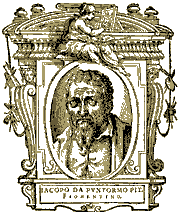Painter and fine portraitist
Pontormo, Empoli 1494-Florence 1556
The pupil and later rival of Andrea del Sarto he was the greatest representative of
the early Florentine Mannerist school. He possessed a tormented and introverted
spirit, loved experimenting and stands out, not only for his careful
research into form and rare colours, but also for his original private
life. He lived all alone in a tall house and his bedroom on the top floor
could only be reached by a ladder which he could raise with a pulley. His "Diary" (1554-56)
shows the depth of his neurosis.
He always lived in Florence under the protection of Medici, apart from
the odd visit to Rome to see masterpieces of Michelangelo Buonarroti which
were to inspire his work with a vibrant monumental style.

Cosimo the Elder
Uffizi
His portrait painting starts out with the Portrait of a Gentlewoman
with a basket of spindles (Uffizi), where his interpretation is more
aggressive compared to the style of Andrea del Sarto; the Portrait
of Cosimo the Elder (Uffizi) contains a tough evocative power, while
he also made the most of the delicate techniques of Bronzino, for example
in his Portrait of a Lady, now in Frankfurt.
He possessed a nervous and varied graphic style, compared to Andrea del Sarto's
measured classicism, and his use of space is almost disturbing for the figures
almost seem to be arranged in diminishing order instead of in depth, giving special
character to his work; this includes the Visitation (1516), frescoed in the
little Cloister dei Voti at the Annunziata,
the Holy Family in San Michele Visdomini (1518), where the taut lines of the
composition find psychological expression in some of the sardonic grimaces.

Church of St. Felicita
Deposition
He also decorated the hall of the Medici villa at Poggio a Caiano (Vertumnus
and Pomona, 1521), the Stories of the Passion in the Cloisters at the
Certosa of Galluzzo (1523-25) inspired by Dürer in an almost provocative
northern style, the Supper at Emmaus (Uffizi), where he anticipates El
Greco and Caravaggio, the Deposition (1525-28, perhaps his masterpiece)
in Santa Felicita and the Visitation at Carmignano.
He developed a style similar to that of Michelangelo after 1530, though using forms that became
more and more involved and abnormal as, for example, in the frescos in the choir
of San Lorenzo, destroyed in 1738, which Vasari describes as melancholy scenes
of piled-up dead bodies.


